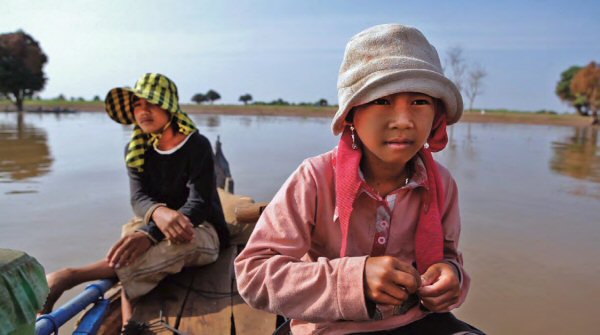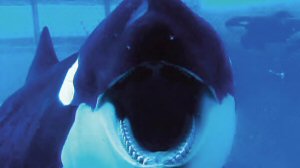SEJournal Online is the digital news magazine of the Society of Environmental Journalists. Learn more about SEJournal Online, including submission, subscription and advertising information.
Feature
By JoANN M. VALENTI
|
|
|
A scene from 'A River Changes Course,' a feature documentary film about the impacts of globalization and climate change on the lives of rural Cambodians. Photo: Kalyanee Mam, Migrant Films |
If change was the subtext of this year’s 2013 Sundance Film Festival, then the topic of climate change came in for serious attention at the prestigious indie film festival, which has become a lens into what films will get wider distribution or even become surprise Oscar contenders like SFF 2012’s “Beasts of the Southern Wild.”
“Change is inevitable,” Sundance Institute founder Robert Redford told reporters at an opening press conference in Park City, Utah, in January. “Some see change as positive, some as negative. [Indie films] give an audience a chance to choose.”
And among the choices for audiences from among more than 1,200 submissions were films on the challenges of covering hard news stories, and focusing on the consequences of climate change and other environment issues.
Enviro docs cover climate, eco-activism, mega-tourism
For instance, the Grand Jury Prize for World Cinema Documentary was awarded to former Cambodian refugee Kalyanee Mam for “A River Changes Course,” the story of a culture, lives and land devastated by climate change and globalization. Mam spent two years following three families who faced the transition from agrarian to low-wage industrialization and the disappearance of natural resources. She captures the sound of rice stalks being harvested, river waters lapping the edges of floating villages and children harvesting sugar cane in the remaining jungle.
The film allows viewers to see from a safe distance families being displaced by deforestation, overfishing and an overall changing environment. Admitting she had no answers to the problems her film exposes, she said, “We need to understand the problem and really discuss the issues.” Solutions will only come from working together, she said.
|
|
|
Above, wild orcas spouting at sea. Below, a captive killer whale, from 'Blackfish,' the story of a performing killer whale that killed several people while in captivity. Photos courtesy of Dogwoof Films. |
|
|
In “The East,” a group of radical eco-activists targets the pharmaceutical industry in an effort to provoke more concern and attention to ethical murkiness. And an advocacy doc, “Blackfish,” retells the horrid stories of ill-informed Sea World trainers attacked, sometimes fatally, by captive orcas. The mistreatment and unnatural conditions imposed on these “killer whales” should prompt further investigations of such “amusement” parks. Another clearly antimega-tourism film, “Escape from Tomorrow,” had the filmmaker worried about lawsuits. The psycho-drama is sure to make you rethink future visits to Anaheim or Orlando.
The Alfred P. Sloan Prize for science in film was awarded to “Computer Chess,” a quirky look back at the beginnings of machine intelligence research. “Filmmakers need to become more comfortable with science and technology,” Sloan juror and WGBH Science Unit Director and Executive Producer of PBS’s NOVA series Paula S. Apsell said in a post-fest interview. The same could be said for more serious environment stories in film.
Journalistic docs seek to move audiences to action
Films are a part of the process of change, with the shared experience of a film motivating an audience to engage, argued filmmakers at the festival. The aim is to alter the thinking of an audience, filmmakers on the “Turning the Tide” panel agreed. The challenge is to drive communities beyond what they see on film and online, to consider priorities.
“The Square,” for example, from Egyptian filmmaker Jehane Noujaim, captures news not covered on state television, she said. American political economist, CNBC commentator, professor and Obama transition advisory board member Robert Reich claimed his 30 years of writing (including 14 books), speaking, and being on the presidential cabinet has had no effect. So he’s moved to film (appearing in “Inequality for All” at this year’s fest) to try to change the widening polemic between the rich and poor.
Panelist and Chilean filmmaker Pablo Larrain said his hope is to move audiences from fear to action and courage. People don’t buy the ad “lies” any longer, whether it’s a microwave “freeing” women from the kitchen or some elected official making a difference, he said. Film narratives can challenge what’s made “illegal,” Larrain added, citing the illegal alien label versus undocumented worker.
Guardian journalist James Ball on the panel “Out of Sight (and Outside the Law)” appears in one of several films on new technology’s impact on communication and privacy: “We Steal Secrets: The Story of WikiLeaks,” “Google and the World Brain,” “Jobs,” a biopic on the Apple founder already being released in theaters, and “Terms and Conditions,” screened at the smaller SlamDance Film festival down the street. While informative, these films will likely also make viewers angry, ready to take on more investigative journalism.
Citing the mantra, “journalism is simple, intelligence is complicated,” Ball and fellow panelists discussed the immorality revealed through war coverage, the persecution of whistleblowers and the risks taken by journalists, particularly local reporters working in war zones. “There’s no finite number of bad guys,” said Peter Bergen, CNN’s national security analyst and author of three bestsellers, noting that reports and accounts provided to journalists are unreliable, “lies pretending to be detailed, accurate.”
Other relevant journalistic screenings at the festival included “Dirty Wars,” an investigation of covert U.S. actions and “Which Way to the Front Line from Here? The Life and Time of Tim Hetherington,” the late photojournalist and filmmaker (“Restrepo”). More information and access to some trailers is available at www.sundance.org.
JoAnn Valenti is a member of the SEJournal editorial advisory board, and an emerita professor coping with retirement.
* From the quarterly newsletter SEJournal, Spring 2013. Each new issue of SEJournal is available to members and subscribers only; find subscription information here or learn how to join SEJ. Past issues are archived for the public here.
















 Advertisement
Advertisement 



